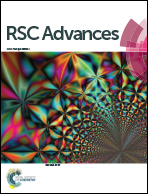Spiro[fluorene-9,9′-xanthene]-based universal hosts for understanding structure–property relationships in RGB and white PhOLEDs†
Abstract
Ingenious construction of state-of-the-art models of electrophosphorescent hosts for uncovering the deep role of different molecular modifications in PhOLEDs performances is crucial for rational cumulative improvements of device efficiency and for accelerating their commercialization. A series of conjugation-interrupted spiro[fluorene-9,9′-xanthene](SFX)/9-arylfluorenes (AFs) hybrid host materials have been designed and synthesized by concise two-step reactions, and have been demonstrated to serve as universal hosts for low voltage blue, green, red and single-emitting layer white PhOLEDs. By varying the electronegativity and position of the bulky AF substitutes, two independent, selective methods for fine tuning frontier molecular orbital energy levels without affecting the high triplet energy level (T1) have been realized. This offers either facilitated hole- or electron-injection/blocking without influencing the optical properties, which can explain the performance of the corresponding RGB PhOLEDs. This investigation provides good guidance for the future rational design of high-performance PhOLED hosts by accumulative structural modifications.
![Graphical abstract: Spiro[fluorene-9,9′-xanthene]-based universal hosts for understanding structure–property relationships in RGB and white PhOLEDs](/en/Image/Get?imageInfo.ImageType=GA&imageInfo.ImageIdentifier.ManuscriptID=C5RA00694E&imageInfo.ImageIdentifier.Year=2015)

 Please wait while we load your content...
Please wait while we load your content...